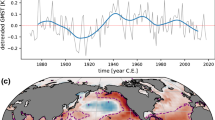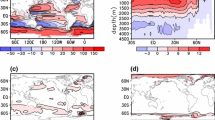Abstract
General circulation model experiments designed to estimate the magnitude and structure of internally generated variability and to help understand the mechanisms underlying this variability are described. The experiments consist of three multi-century integrations of a rhomboidal 15, 9 level, version of the Center for Ocean-Land-Atmosphere Studies atmospheric general circulation model: a run with fixed sea surface temperatures and equinox solar radiation, a run with seasonally varying climatological sea surface temperatures and seasonally varying solar forcing, and a run with seasonally varying solar forcing in which the state of the ocean is predicted by a 3° by 3°, 16 vertical level, nearly global domain version of the Geophysical Fluid Dynamics Laboratory Modular Ocean Model. No flux correction is used in the coupled model integration. Selected surface fields of the three runs are compared to each other as well as to the observed climate. Statistical properties of variability on interannual time scales are compared between the runs. Evidence is presented that climate time scale variability in the simulations is produced by random weather time scale forcing due to the integrating effect of elements of the system with long memories. The importance of ocean variability for land climate variability is demonstrated and attributed to both the memory effect and coupled atmosphere-ocean instability.
Similar content being viewed by others
References
Anthes RA (1977) A cumulus parameterization scheme utilizing a one dimensional cloud model. Mon Weather Rev 105:270–286
Bryan K, Lewis L (1979) A water mass model of the world ocean. J Geophys Res 84:2503–2517
Cane MA, Zebiak SE (1985) A theory for El Niño and the Southern Oscillation. Science 228:1085–1087
Charney JG (1947) The dynamics of long waves in a baroclinic westerly current. J Meteorol 4:135–163
Charney JG (1975) Dynamics of deserts and drought in the Sahel. Q J R Meteorol Soc 101:193–202
Charney JG, Straus DM (1980) Form-drag instability, multiple equilibria and propagating planetary waves in baroclinic, orographically forced, planetary wave systems. J Atmos Sci 37:1157–1176
Eady ET (1949) Long waves and cyclone waves. Tellus 1:33–52
ECMWF Research Department (1988) Research Manual 3. ECMWF forecast model physical parameterization. European Centre for Medium Range Weather Forecasts, Shinfield Park, Reading, UK
Gordon CT, Stern WF (1982) A description of the GFDL global spectral model. Mon Weather Rev 110:625–644
Harshvardhan, Davies R, Randall DA, Corsetti TG (1987) A fast radiation parameterization for atmospheric circulation models. J Geophys Res 92 (131):1009–1016
Hasselmann K (1976) Stochastic climate models. Part 1. Theory. Tellus 28:473–485
Hou Y-T (1990) Cloud-radiation-dynamics interactions. PhD Dissertation, University of Maryland
Hunt BG (1988) Nonlinear influences — a key to short term climatic perturbations. J Atmos Sci 45:387–395
Intergovernmental Panel on Climate Change (1991) Climate Change. The IPCC Scientific Assessment. Houghton JT, Jenkins GJ, Ephraums JJ (eds) Cambridge University Press, Cambridge
Jones PD, Raper SCB, Cherry BSG, Goodness CM, Wigley TML, Santer B, Kelly PM, Bradley RS, Diaz HF (1991) An updated global grid point surface air temperature anomaly data set: 1851–1990. Environmental Sciences Division Publication No. 3520. Oak Ridge National Laboratory, Oak Ridge, Tenn., USA (ORNL/CDIAC-37, NDP-0201R1)
Kinter JL III, Shukla J, Marx L, Schneider EK (1988) A simulation of the winter and summer circulation with the NMC global spectral model. J Atmos Sci 45:2486–2522
Kuo HL (1965) On the formation and intensification of tropical cyclones through latent heat release by cumulus convection. J Atmos Sci 22:40–63
Lacis AA, Hansen JE (1974) A parameterization for the absorption of solar radiation in the earth's atmosphere. J Atmos Sci 32:118–133
Lau N-C, Philander SGH, Nath MJ (1992) Simulation of ENSO-like phenomena with a low-resolution coupled GCM of the global ocean and atmosphere. J Clim 5:284–307
Levitus S (1982) Climatological atlas of the world ocean. NOAA Prof Pap 13. US Dep Commerce
Lindzen RS, Nigam S (1987) On the role of sea surface temperature gradients in forcing low-level winds and convergence in the tropics. J Atmos Sci 44:2418–2436
Lorenz EN (1967) The nature and theory of the general circulation of the atmosphere. WMO Publ No. 218: TP 115. World Meteorological Organization, Geneva, Switzerland
Lorenz EN (1976) Nondeterministic theories of climate change. Quat Res 6:495–506
Manabe S, Stouffer RJ (1988) Two stable equilibria of a coupled ocean-atmosphere model. J Clim 1:841–866
Mellor GL, Yamada T (1982) Development of a turbulence closure model for geophysical fluid processes. Rev Geophys Space Phys 20:851–875
Miyakoda K, Sirutis J (1977) Comparative integrations of global spectral models with various parameterized processes of subgrid scale vertical transports. Beitr Phys Atmos 50:445–487
Pacanowski R, Philander SGH (1981) Parameterization of vertical mixing in numerical models of tropical oceans. J Phys Oceanogr 11: 1443–1451
Philander SGH (1990) El Niño, La Nina and the Southern Oscillation. Academic Press
Philander SGH, Pacanowski RC, Lau N-C, Nath MJ (1992) Simulation of ENSO with a global atmospheric GCM coupled to a high-resolution, tropical Pacific Ocean GCM. J Clim 5:308–329
Phillips NA (1957) A coordinate system having some special advantages for numerical forecasting. J Meteorol 14:184–185
Sato N, Sellers PJ, Randall DA, Schneider EK, Shukla J, Kinter JL III, Hou Y-T, Albertazzi E (1989) Effects of implementing the simple biosphere model (SiB) in a general circulation model. J Atmos Sci 46:2752–2782
Schneider EK, Lindzen RS (1977) Axially symmetric steady-state models of the basic state for instability and climate studies. Part I. Linearized calculations. J Atmos Sci 34:263–279
Sela JG (1980) Spectral modeling at the National Meteorological Center. Mon Weather Rev 108:1279–1292
Sellers PJ, Mintz Y, Sud YC, Dalcher A (1986) A simple biosphere model (SiB) for use within general circulation models. J Atmos Sci 43:505–531
Slingo JM (1987) The development and verification of a cloud prediction scheme for the ECMWF model. Q J R Meteorol Soc 113:899–927
Slutz RJ, Lubker SJ, Hiscox JD, Woodruff SD, Jenne RL, Joseph DH, Steurer PM, Elms JD (1985) Comprehensive ocean-atmosphere data set; release 1. NOAA Environmental Research Laboratories, Climate Research Program, Boulder, Colo. (NTIS PB86–105723)
Tiedtke M (1984) The effect of penetrative cumulus convection on the large-scale flow in a general circulation model. Beitr Phys Atmos 57:216–239
Wallace JM, Gutzler DS (1981) Teleconnections in the geopotential height field during the Northern Hemisphere winter. Mon Weather Rev 109:784–812
Xue Y, Sellers PJ, Kinter JL III, Shukla J (1991) A simplified model for global climate studies. J Clim 4:345–364
Zebiak SE, Cane MA (1987) A model of El Niño-Southern Oscillation. Mon Weather Rev 115:2262–2273
Author information
Authors and Affiliations
Rights and permissions
About this article
Cite this article
Schneider, E.K., Kinter, J.L. An examination of internally generated variability in long climate simulations. Climate Dynamics 10, 181–204 (1994). https://doi.org/10.1007/BF00208987
Received:
Accepted:
Issue Date:
DOI: https://doi.org/10.1007/BF00208987




